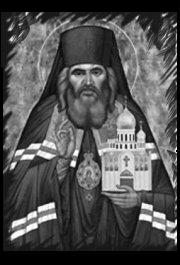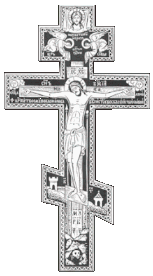
| HOME |
REBELLION |
TRUTH |
RESURRECTION |
LINKS |
CONTACT |
ARCHBISHOP JOHN
The relics - the body - of Archbishop John, however, are found to be totally incorrupt. His skin was white an soft, and upon lifting out his body it was found to be very light due to dehydration but was totally intact. Those who came forward to venerate the relic discovered that they exuded a sweet fragrance.
Exposure of a body to amount of moisture that deteriorated metal and other objects would surely caused rapid decomposition. There is thus no basis to argue that Archbishop John’s body had undergone some sort of mummification.
The incorruptibility of a saint's relics is a sign of God's special favor and grace. It is also a testimony of the eternal blessedness that awaits the elect of God. It is clear from Holy Scipture (read in the Old Testament the 2nd book of Kings 2:14., and 13:21, and in Acts 19:12) that God has manifested miracles through His saints, from ancient times even to our own age.
What better description could be found to portray the essence of a man whose love for Christ drew him to such heights of spiritual perfection that he enkindled the faith of thousands from East to West? The life of Archbishop John Maximovitch demonstrates more vividly than any words that true Christianity far exceeds the bounds of human "goodness". Here is a shining reflection of the supernatural love of God which works miracles, a living proof that the burning faith of the early Christian saints still warms the earth at a time when the love of many has grown cold.
Archbishop John did not isolate himself from the world, but he was not of this world. First and foremost he was man of prayer. He completely surrendered himself to God, presenting himself as a "living sacrifice" and he became a true vessel of the Holy Spirit. His work continues even now today.
This holy man of God was born 4 June, 1896 in the province of Kharkov in southern Russia. At baptism he was given the name Michael. As a child he was serious for his years and he later wrote: "From the first days when I began to become aware of myself, I wished to serve righteousness and truth. My parents kindled in me a striving to stand unwaveringly for the truth, and my soul was captivated by the example of those who had given their lives for it."
Shanghai, 1934
Following the desire of his parents, he entered law school in Kharkov. He was naturally gifted student but spent more time reading Lives of Saints then attending academic lectrues. "While studying the worldly sciences," he wrote, "I went all the more deeply into the study of the science of sciences, into the study of the spiritual life."
After the Revolution in Russia, he was evacuated together with his family to Belgrade where entered the faculty of theology at the University. In 1926, a year after his graduation, he was tonsured a monk and given the name John, after his own distant relative who was a canonized saint in Russia and he was known as St. John of Tobolsk (Archbishop John was buried with an icon of his saintly relative). In November of that same year, he was ordained hieromonk (a priestmonk). Soon he became a teacher at the Serbian Seminary of St. John the Theologian at Bitol. More than once the bishop of that diocese would say, "If you wish to see a living saint, go to Father John."

Ascetic
It was his own students who first became aware of Vladika's great feast of asceticism. At night they noticed that Vladika would stay up, making the rounds of the dormitories and praying over the sleeping students. "Finally, it was discovered that he scarcely slept at all, and never in a bed, allowing himself only an hour or two each night of uncomfortable rest in a sitting position, or bend over on the floor, praying before icons." This ascetic feat he continued for the rest of his life, bringing his body "into subjection" according to the holy Apostle Paul, "But I discipline my body and bring it into subjection, lest, when I have preached to others, I myself should become disqualified" (I Corinthians 9:27).
At the age of 38 he was elevated to the episcopate and sent to Shanghai. There he restored Church unity, took an active interest in the religious education of youth, encouraged and participated in various chairitable organizations, founded an orphange, and himself gathered sick and starving children off the streets. He always wore clothing of the cheapest Chinese fabric and often went barefoot, sometimes having given his sandals away to some poor man. Vladika celebrated Holy Divine Liturgy and received Holy Communion daily, as he did for the rest of his life.
Wonderworker
In Shanghai it became evident that Vladika John was not only a righteous man, but a true ascetic, a man of prayer and a wonderworker. "Once in Shanghai Vladika John asked to the bed of a dying child, whose case had been called hopeless by the physicians. Entering the apartment, Vladika John went straight to the room in which the sick boy lay, although no one managed yet to show him where this was. Without examining the child, Vladika immediately 'fell down' in front of the icon in the corner, which was very characteristic of him, and prayed for a long time. Then, assuring the relatives that the child would recover, he quickly left. And in fact the child became better towards morning and he soon recovered, so that a physcician was no longer needed."
Vladika John loved to visit the sick and if the condition of a patient would become critical, he would go to him at any hour of the day or night to pray at his bedside. There were cases when patients would cry out to Vladika in the middle of the night from the hospital beds, and the end of the city Vladika John would come without even calling him by phone.
Man of Prayer
When the coming of the communists, the Russians in China were forced once again to flee, most through the Philippines. At one time 5,000 of the refugees were living in an Internaltional Refugee Organization camp on the island of Tubabao, located in the path of typhons.
When the fear of typhons was mentioned by one Russian to the Filipinos, they replied that there was no reason to worry, because " 'your holy man blesses your camp from four directions every night.' They referred to Vladika John, for no typhoon struck the island while he was there."
In trying to resettle his flock in Christ our Lord, Vladika John went to Washington D.C. (he visited with Father Constantine at the Russian Orthodox Cathederal of St. John the Baptist, who later became Bishop Constantine, who recently reposed in the Lord), knowing Bishop Constantine myself, he told me this story about Vladika John's presence in Washington at the Cathederal: Vladika John had a meeting before the house senate, to appeal for the Russian refugees, and he had to be at that meeting at a certain hour, Bishop Constantine told me, however the pious Vladika John said he would go to the meeting after he celebrated the Divine Liturgy, once the Liturgy was over, he went to the Senate on behalf of the Russian refugees, and he was late! Once the little of stature holy man Vladika John entered the Senate they had already moved on to another agenda, being Vladika John did not arrive on time. Everyone in the Senate stood up out of respect for they had noticed a holy man of God had entered the room, and then wanted to hear his appeal on behalf of the Russian refugees in the Philippines. After Vladika John gave his report before the Senate Committee, the refugees were able to come to America and live in San Francisco, California, under the supervision and direction of Vladika John. All of the Russian refugees through the intervention of Vladika John miraculoulsly able to come to America - including his orphange, in which he later established in San Francisco, and became known as St. Tikhon Orphange.
In 1951 Vladika John was sent to Western Europe as a Bishop. Here too his reputation for holiness spread - and not only among the Orthodox. In one of the Catholic churches of Paris, a priest strove to inspire his young people with these words: 'You demand proofs, you say that now there are neither miracles nor saints. Why should I give you theoretical proofs, when today there walks in the streets of Paris a saint - St. Jean Nus Pieds (St. Jon the Barefoot).'
Alive after Death - repose in the Lord
On 19 June (2 July new style), 1966, during a Archpastoral visit to Seatte, Washington with the wonder-working Kursk icon of the Mother of God, Vladika John peacefully gave his soul to the Lord to whom he had served so faithfully during his earthly life. I learned this account of the blessed repose of Vladika John: after Vladika John served Holy Divine Liturgy, a parish member asked Vladika to serve a 'Memorial Service', in which he did, then after a light meal in the Church hall, he went to rest in a private room provided for him, (but it's really not known if he actually rested), suddenly someone heard a noise from his room, and Vladika John was found on the floor before the holy icon of the Mother of God of Kursk. Without any doubt Vladika John gave his sweet soul to the Lord to whom he served so faithfully during his earthly life.
His unembalmed body was flown to San Francisco, California where for six days it lay in the cathedral in an open coffin, it was said that His Eminence Metropolitan Philaret (reposed in the Lord, 21 November 1985), wanted to attend the funeral service in San Francisco, and Vladika Philaret was at the time in New York, due to the fact that Vladika Philaret had at the time heart problems, it was not suggested that he fly to San Francisco by plane, and so instead took a train, this of course delayed the funeral for the newly - reposed Vladika John. However this did not matter because even when Vladika Philaret arrived at the Joy of All Who Sorrow Russian Orthodox Cathederal in San Francisco, for the funeral, Vladika John had no sign of decay, and it was said that Vladika John looked pure, and that a sense of spiritual beauty was felt when anyone approached his coffin during his funeral at the Church.
From the first day of the vigil it was apparent that this was to be no ordinary farewell to the newly departed in the Lord Vladika John, not even for a Hierarch (a bishop of the Orthodox Church). There was a sense of being present at the unfolding of a mystery: the mystery of holiness, that still exist until this day. "Those present were devoutly convinced that they had come to bury a saint."
Since the reposed of Vladika John many of the faithful called him Blessed John, and for these many years his tomb or sepulcher (Blessed Vladika John was buried under the Church of the Cathederal of the Joy of All Who Sorrow, in San Francisco, California, on Geary, Blvd.), had been a place for pilgrimage for thousands and thousands of Orthodox Christians throughout the world, before his holy Canonization on 2 July, 1994.
 |
Back to top |